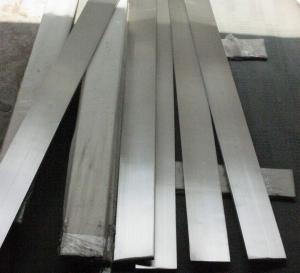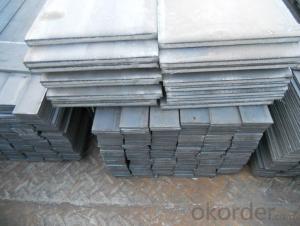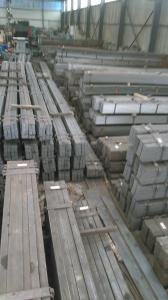Steel Flat Bar with High Quality for Construction
- Loading Port:
- China main port
- Payment Terms:
- TT or LC
- Min Order Qty:
- 25 m.t.
- Supply Capability:
- 10000 m.t./month
OKorder Service Pledge
OKorder Financial Service
You Might Also Like
Specification of Steel Flat Bar with High Quality for Construction:
Commodity: Hot Rolled Steel Flat Bar
Standard: GB;JIS
Material: Q195-Q235
Brand name: FLATSPACE
Origin place: China
Thickness: 3mm-30mm
Width:20mm-200mm
Length: Max 12m
Certification: SGS/BV
Usage/Applications of Steel Flat Bar with High Quality for Construction:
Widely used for construction, Machinery manufacturing, Iron tower steel structure, Shipbuilding; Steel grating, Staircase, Bridge, Viaduct, Railway spare parts, Boilers making etc.
Production Flow of Steel Flat Bar with High Quality for Construction:
The steel flat bar is made through three processes:
1.Feeding the material: Feeding the row material (the steel plate) to Slitting Line.
2.Slitting:The steel plate would be slitted into expected width by lengthways cutter.
3. Leveled and cutting: The plat bar would be ground into level by the grinder and then cut into required length.
Packaging & Delivery of Steel Flat Bar with High Quality for Construction:
1.Packaging Details: The Steel Flat Bars are packed in bundles and loaded in 20 feet/40 feet container, or shipped by bulk cargo ,also we can do as customer's requirements.
2.Delivery Details:30~45 days upon the receipt of buyer payment by T.T. or L/C.
3. Marks:
Color marking: There will be color marking on both end of the bundle for the cargo delivered by bulk vessel. That makes it easily to distinguish at the destination port.
Tag mark: there will be tag mark tied up on the bundles. The information usually including supplier logo and name, product name, made in China, shipping marks and other information request by the customer.
If loading by container the marking is not needed, but we will prepare it as customer requests.
FAQ:
Q1: Why buy Materials & Equipment from OKorder.com?
A1: All products offered byOKorder.com are carefully selected from China's most reliable manufacturing enterprises. Through its ISO certifications, OKorder.com adheres to the highest standards and a commitment to supply chain safety and customer satisfaction.
Q2: How do we guarantee the quality of our products?
A2: We have established an advanced quality management system which conducts strict quality tests at every step, from raw materials to the final product. At the same time, we provide extensive follow-up service assurances as required.
Q3: How soon can we receive the product after purchase?
A3: Within three days of placing an order, we will begin production. The specific shipping date is dependent upon international and government factors, but is typically 7 to 10 workdays.
Images:
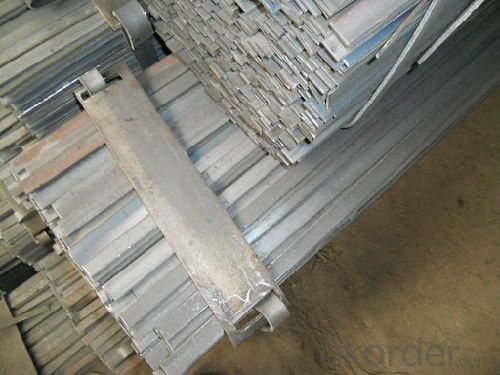
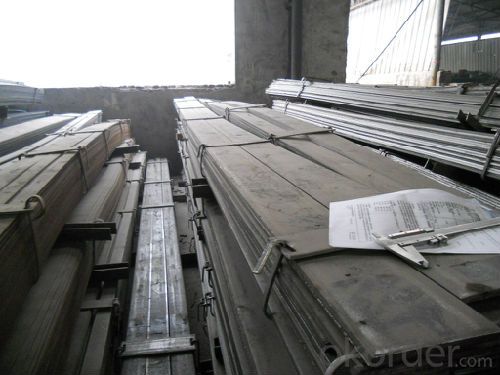
- Q:Are steel flat bars available in non-standard lengths?
- Yes, steel flat bars are available in non-standard lengths. While standard lengths for steel flat bars are typically 20 feet or 6 meters, many suppliers offer custom cutting services to provide the desired length. This allows customers to order steel flat bars in non-standard lengths according to their specific project requirements. By offering this flexibility, suppliers cater to a wide range of needs and ensure that customers receive the exact length they need for their applications.
- Q:Are steel flat bars available in different colors or coatings?
- Different colors or coatings are not typically available for steel flat bars. Steel is usually left in its natural state, which is a dark gray or silver color. However, it is possible to add coatings or finishes to steel flat bars for specific purposes like protecting against corrosion or improving appearance. These coatings may include galvanized coatings that add a layer of zinc to prevent rusting, or powder coatings that can provide color to the steel. However, these coatings are usually applied after the steel has been shaped into flat bars and are not easily found in a wide variety of colors or finishes.
- Q:What are the applications of steel flat bars?
- Steel flat bars find a wide range of applications in various industries. Construction and structural engineering are among the most common uses. They serve as a structural component in buildings, bridges, and other infrastructure projects, providing strength and stability to withstand heavy loads and forces. The manufacturing industry utilizes steel flat bars in machinery and equipment production. They serve as a base or support for heavy machinery and are used in constructing frames, brackets, and components. The high strength and durability of steel flat bars make them ideal for handling the stress and pressure generated during operation. In the automotive industry, steel flat bars are commonly used in the manufacturing of vehicle frames, chassis, and body panels. Their strength and rigidity ensure the structural integrity of automobiles, contributing to safety and stability. Furthermore, the fabrication industry extensively employs steel flat bars. They are frequently used in fabricating gates, fences, grills, and handrails. The versatility of steel flat bars allows for easy shaping, cutting, and welding, making them an excellent choice for custom fabrication projects. Apart from these industries, steel flat bars have various other applications. They are commonly found in furniture, shelves, and storage racks due to their high load-bearing capacity. Additionally, they are utilized in the production of agricultural equipment like plows and harrows, as well as tools and hardware. In summary, steel flat bars are highly versatile and widely used in construction, manufacturing, automotive, fabrication, and many other industries. Their strength, durability, and versatility make them a popular choice across various applications.
- Q:What are the different types of corners available for steel flat bars?
- Steel flat bars typically come with two types of corners: square corners and rounded corners. 1. Square corners: This is the most common type of corner available for steel flat bars. As the name suggests, the corners are square or 90-degree angles. Square corners provide a clean and sharp appearance and are often preferred when a precise and angular look is desired. They are also easier to fit and join with other materials, making them versatile for various applications. 2. Rounded corners: Some steel flat bars are manufactured with rounded corners instead of square corners. Rounded corners have a smooth curve rather than a sharp angle, providing a more streamlined and aesthetically pleasing appearance. This type of corner is often chosen for safety reasons, as it eliminates potential sharp edges that can cause injuries. Rounded corners are commonly used in architectural and decorative applications where a softer and more visually appealing design is desired. The choice between square corners and rounded corners depends on the specific requirements of your project. Consider factors such as the intended application, safety considerations, design preferences, and ease of installation when selecting the appropriate type of corner for your steel flat bars.
- Q:Are steel flat bars available in different colors or finishes?
- No, steel flat bars are typically not available in different colors or finishes. Steel is often left unfinished or coated with a protective layer to prevent rust or corrosion.
- Q:Are steel flat bars available with pre-drilled holes?
- Yes, steel flat bars are available with pre-drilled holes.
- Q:What is the typical hardness of steel flat bars?
- The typical hardness of steel flat bars can vary depending on the specific grade and heat treatment, but generally, they range from 40 to 65 on the Rockwell hardness scale. This hardness level ensures that steel flat bars are strong, durable, and able to withstand various mechanical stresses and impacts. However, it is important to note that hardness can be adjusted through different heat treatment processes to meet specific requirements for different applications.
- Q:Can steel flat bars be galvanized?
- Yes, steel flat bars can be galvanized. Galvanization is a process of applying a protective zinc coating to steel to prevent rusting and corrosion. It is typically done by immersing the steel in a bath of molten zinc or by electroplating. Galvanizing steel flat bars helps increase their durability and lifespan in various applications, especially in outdoor or corrosive environments.
- Q:Are steel flat bars available in customized lengths?
- Yes, steel flat bars can be available in customized lengths to meet specific requirements and project needs.
- Q:What are the different methods of surface etching for steel flat bars?
- Steel flat bars can be etched using various methods, each with its own advantages and applications. Here are some commonly used techniques: 1. Chemical Etching: By selectively removing the surface layer with chemical solutions or acids, this method allows for precise depth and pattern control. It is versatile, capable of creating intricate designs, logos, or text on the flat bar. 2. Electrochemical Etching: Also known as electrolytic etching, this method dissolves the surface layer using an electric current. A stencil or mask guides the process, making it ideal for permanent markings like part numbers or identification codes. 3. Laser Etching: Utilizing a high-powered laser without direct contact, this method ensures precise control and high-resolution patterns. It is frequently employed in industries that demand precision and permanence, like aerospace or medical equipment manufacturing. 4. Sandblasting: By propelling abrasive particles at high speed onto the flat bar's surface, sandblasting creates a textured or roughened finish. It is commonly used to enhance coating adhesion, create decorative finishes, or prevent slips. 5. Mechanical Etching: This technique physically removes the surface layer using mechanical means, such as milling, grinding, or polishing. It is often used to achieve specific finishes or textures for architectural or interior design purposes. Each method offers unique benefits, and the choice depends on the specific requirements of the application. Factors such as cost, precision, speed, and desired outcome should be considered when selecting the appropriate surface etching method.
1. Manufacturer Overview |
|
|---|---|
| Location | |
| Year Established | |
| Annual Output Value | |
| Main Markets | |
| Company Certifications | |
2. Manufacturer Certificates |
|
|---|---|
| a) Certification Name | |
| Range | |
| Reference | |
| Validity Period | |
3. Manufacturer Capability |
|
|---|---|
| a)Trade Capacity | |
| Nearest Port | |
| Export Percentage | |
| No.of Employees in Trade Department | |
| Language Spoken: | |
| b)Factory Information | |
| Factory Size: | |
| No. of Production Lines | |
| Contract Manufacturing | |
| Product Price Range | |
Send your message to us
Steel Flat Bar with High Quality for Construction
- Loading Port:
- China main port
- Payment Terms:
- TT or LC
- Min Order Qty:
- 25 m.t.
- Supply Capability:
- 10000 m.t./month
OKorder Service Pledge
OKorder Financial Service
Similar products
New products
Hot products
Related keywords





















